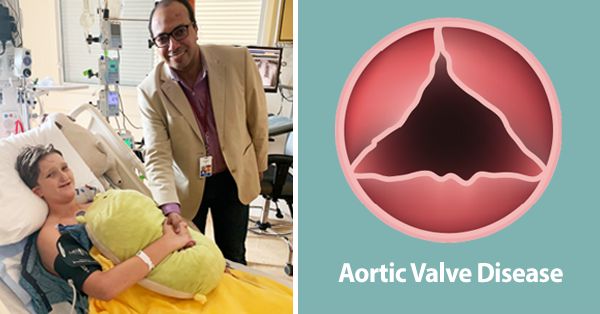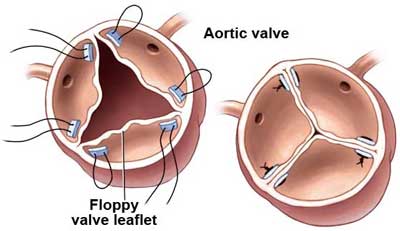Pediatric Aortic Valve Surgery: Top 8 Facts
Written By: Adam Pick – Patient, Author & HeartValveSurgery.com Founder
Medical Expert: Dr. Sameh Said – Associate Professor of Surgery & Pediatrics, University of Minnesota
Post Last Updated: December 22, 2020
After the extraordinary response to our first post about pediatric heart valve surgery (which had over 5,000 Facebook Likes), I am excited to expand our educational coverage of this topic specific to the aortic valve.
As you may already know, aortic valve diseases including aortic stenosis and aortic regurgitation are very common in adult patients. But, what about children? Is aortic valve disease a serious health problem that parents should be looking out for? If so, are treatments available to help newborns, infants, toddlers and teenagers with aortic valve disease?

I wanted to get an expert medical opinion on those questions and more. For those reasons, I contacted Dr. Sameh Said, a leading pediatric valve surgeon and Associate Professor of Surgery and Pediatrics, Division of Pediatric Cardiovascular Surgery, Masonic Children’s Hospital at the University of Minnesota, in Minneapolis, Minnesota. As you can see at Dr. Said’s surgeon profile, he has successfully treated many children in our community. Here are the highlights from my exchange with Dr. Said.
Fact 1. Is it common for children to be born with aortic valve disease? What are the common types of aortic valve disease that you see in your practice?
Aortic valve disease can present as stenosis (narrowing) and/or regurgitation (leakage). I see all types of aortic valve disease in my practice, however the majority of presentation in neonates and infants are due to congenital aortic valve stenosis. This represents probably 3-5% of all patients with congenital heart disease.
Normal aortic valve has three cusps but sometimes can be bicuspid (has two cusps). This is considered one of – if not – the most common congenital cardiac anomalies and is present in about 1-2% of the population. Those with bicuspid aortic valve tend to present later in life and the majority do not have aortic stenosis in childhood and are asymptomatic.

Fact 2. What are the common causes of aortic valve disease in children?
Most aortic valve stenosis results from abnormal aortic valve structure and is congenital in nature. This means the child is born with a structurally abnormal valve such as two cusp (bicuspid) or unicuspid (one cusp) valve. This can also take a wide range of presentation in terms of timing or age at presentation and can be isolated or associated with other congenital heart defects, the most extreme of which is hypoplastic left heart syndrome.
On the other hand, aortic valve regurgitation is often secondary to other congenital cardiac problems. Isolated congenital aortic valve regurgitation itself is a relatively rare problem.
Some of the common scenarios that we see aortic valve regurgitation is: (1) after balloon dilation of congenital aortic valve stenosis, (2) in association with a hole in the heart, between the two pumping chambers (ventricular septal defect/VSD), (3) it also occurs due to interference with the aortic cusps from some tissues that grow underneath the valve, known as “subaortic membrane”, and (4) in association with some syndromes such as Marfan where the entire first part of the aorta “aortic root” gets enlarged resulting in lack of coaptation of the aortic valve cusps.
Finally, infection can also result in aortic valve regurgitation. This is known as endocarditis and is a serious problem.
Fact 3. We understand that aortic valve disease is palliative with a tendency for repeat interventions. Why is that important for parents to know?
This is important as it sets expectations. It also helps in future planning. In congenital heart surgery, we no longer think about the current operation only, we think about what to do next and what is after.
It is a balance between minimizing the number of repeat operations/interventions and enjoying a good quality of life with no limitations for the child.
I also want to clarify that while many of the true aortic valve disease scenarios require repeat operations, the durability and long-term outcomes of many of these procedures are quite good to excellent.
Fact 4. Is there a preferred approach for treating a defective aortic valve? If so, what is that treatment?
It depends on the nature of the problem. As a common example, a child born with a stenotic aortic valve and in absence of any other associated heart problems, will probably undergo a balloon dilation of the valve in the cardiac catheterization laboratory. This procedure is pretty much standard in several centers as a first step due to the obvious advantage which is avoiding surgery. It has excellent results in experienced hands but is not suitable for everyone.
When it comes to surgery, repair is always the first step, especially in children. We always thinking about how to repair the aortic valve, even the most challenging ones. The results of the repair is probably better in those with leaking valves compared to narrow valves.

When the valve is not repairable or has been repaired before, it may be difficult to attempt another repair with good durability and replacement comes into discussion. Several options now exist, and the choice depends on several factors such as: Age of the child? Are we dealing with a leaking or narrow valve or both? What number operation is this? Previous valvular interventions? Expectation regarding quality of life?
Fact 5. Why are aortic valve replacements not ideal for children?
Aortic valve replacement is not ideal, and this is not just for children but for adults too. But, sometimes it is necessary or is the only option. Overall data from literature showed that survival decreases in comparison with normal population when aortic valve is replaced with a prosthesis.
In children, the use of prostheses is not desirable due to the lack of growth potential of prostheses, the need for repeat replacement is required especially when the valve replacement process starts early in life. If we also compare the outcomes between biological and mechanical prostheses, biological prostheses have worse outcomes in children due to early and rapid failure and degeneration of the prosthesis. When considering the mechanical option, the need for life-long use of blood thinner significantly affect the child’s quality of life due to the risks associated with blood thinners.
Now to be more accurate, other treatment options such as the Ross Procedure or Ozaki Procedure are also considered aortic valve replacement, but they are different from standard prostheses especially in relation to their dynamics.
Fact 6. We’ve heard a little about the Ozaki aortic valve reconstruction procedure. What should our community know about that new technique?
The Ozaki procedure is gaining popularity recently and is widely spreading in children and young adults. It is not an aortic valve repair as some centers advertise, it is another form of aortic valve replacement, but the patient’s own pericardium is used to create three new cusps to replace the patient diseased aortic valve.
The procedure was introduced by Professor Ozaki in Japan to address aortic valve disease in adults and his data included older patients in the majority of it. He is probably the only one who has a bit of longer-term data, and it looks encouraging so far. We – like others – adopted the procedure at our center as well. I consider the procedure another option that I discuss with parents prior to any aortic valve operation. By the way, the idea of reconstructing one or more aortic valve cusps with pericardium is not new. But, the advantage of the Ozaki is the way it is standardized to make it easy to perform.
While the idea of using the patient’s own pericardium may sound very appealing, we do not have any mid-term or long-term data yet. I see the procedure as another option to use in children. It has several advantages such as: lack for need for any blood thinner, it does not burn any bridges and theoretically a repeat operation after Ozaki should not be difficult. We have also used it using the patient’s own pericardium in primary operations and in those who do not have pericardium (underwent previous surgery where the pericardium was removed to repair other heart defects), we have used bovine pericardium to build the cusps.
Fact 7. When and how do you use the Ross Procedure in your practice?
The Ross Procedure is probably the standard option for aortic valve replacement in children and young adults. It is, however, a technically demanding operation and its success depends on a good patient selection and the surgical technique. It is also the only operation that is associated with excellent survival which is better than any other aortic valve replacement option and is almost close to normal population.

But, there is still risk for need for reoperation or intervention which could be challenging. I personally prefer to do the procedure when the child is fully grown so we can have the longest duration and freedom from reoperation possible.
I discuss all the above options with the parents and now with the introduction of the Ozaki procedure, I will consider the Ozaki first, prior to the Ross operation, especially in younger patients, those with small aortic roots, and if they are not suitable for the Ross.
Fact 8. What is your #1 piece of advice for parents who have children with aortic valve disease?
I have a few key pieces of advice for parents of children with aortic valve disease:
- Be patient and make sure your cardiologist/surgeon discuss all options with you including repair and all of the replacement options.
- Try to understand the pros and cons of each choice and understand that each child is different and there is no “one rule” that fits all.
- I also want to assure the parents that these days we have several options for aortic valve disease, and the overall outcomes are excellent and the quality of life is quite good. The down side, however, is the need for repeat procedures.
Many Thanks to Dr. Sameh Said!!!
On behalf the patients, the parents, their family members and friends, I want to extend a big “Thank You!” to Dr. Sameh Said for helping our community learn more about pediatric heart surgery for the aortic valve.
Related Links:
- Top 5 Facts About Pediatric Heart Valve Surgery
- Free eBook: The Advantages of The Ross Procedure
- Dr. Sameh Said: Interactive Surgeon Profile
Keep on tickin!
Adam





